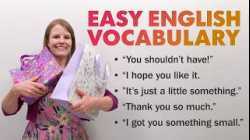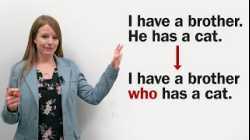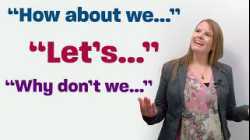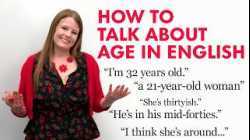
Sound more natural in English: Learn and practice 5 FRONT VOWELS สาธารณะ
ประเภท:
ลักษณะ:
Do you want to improve your pronunciation? Do you want to sound more like a native speaker? You need to work on your vowels! In this video, I will teach you how to pronounce five vowels that are common in both British English and American English. These vowels are known as front vowels. Ill help you pronounce these vowels correctly by showing you what your mouth and lips should look like during pronunciation. We will practice the vowels together and compare them to each other. Watch my mouth as I pronounce different vowel sounds and make sure youre doing the same with yours. Many English learners have a hard time with pronunciation because English is not a phonetic language. So I will show you the different spellings of these sounds in English. You will also learn the International Phonetic Alphabet (IPA) symbols for these vowels.
QUIZ: http://www.engvid.com/english-pronunciation-5-front-vowels/
TRANSCRIPT
Hi there. My name is Emma, and in todays video I am going to teach you about pronunciation, specifically how to pronounce front vowels. Okay? So, you might be wondering: "What is a vowel?" first question, and: "What is a front vowel?" So these are very good questions. So let me show you first what a vowel is. So we have here: "a", "e", "i", "o", "u", and "y". In English, these are our vowels. Okay? So, theyre different from consonants. What a consonant is is a consonant is a sound such as: "t", "d", "r", "s". So, these are vowels in green, and what you see in purple, theres a lot more of them, theyre consonants. So anything that is not one of these is called a consonant.
Okay, so first thing I want to look at is: Where are the vowels in these words, and which are the consonants? We have the word: "king", so where is the vowel here? If we look up here at our list, we have "i" here, "i" here. So this is the vowel, whereas "k", "n", and "g" are consonants. If we look at our next word: "cake", what is the vowel in this word? If you said the "a", youre correct. "Cake". Now, the "e" in "cake" we dont pronounce, so its not a vowel because we dont actually pronounce the sound. We have here the word: "sheet". Whats the vowel in "sheet"? You said an "e", youre correct. Okay? Whereas "s", "h", and "t" are all consonant sounds. Okay, we also have the word here: "ship". Here is the vowel, the "i". And again, "s", "h", and "p" are consonants. What about "happy"? Whats the vowel in "happy"? If you said the "a" and the "y", youre correct. These are the vowels. Okay? Whereas "h", "p", and "p" are consonants.
So in English, we have: "a", "e", "i", "o", "u", and "y" are the way we spell vowels. But heres the problem or heres the thing thats really difficult for a lot of people: If you look at these two words, we have "a" here and "a" here, both vowels. These as, even though theyre spelt the same way, they have the same spelling, we pronounce them differently. Okay? So for example, this, I would say: "Mat", "mat", just like the word "at", "mat". Whereas this word is actually: "Mate", "mate". So, "mat" and "mate". So they have different sounds even though they have the same "a" in the spelling. So what does this mean? This means that for each of these symbols they have multiple sounds. There are different vowel sounds for each of these. Okay? So, this, for example, is an "a", it can be pronounced: "awh", it can be pronounced: "ah". Theres different pronunciations for it. So, in todays lesson Im going to explain some of these different pronunciations. Okay?
So before we begin, I want to talk about how to pronounce vowels. Okay? What you should be really thinking about when youre pronouncing these sounds. The first thing you really should be thinking about is what your lips are doing. Okay? So these are your lips. So when you make a sound, you need to think: Are your lips spread like this, are they very...? Like, for example: "e", you see its very big and spread, or is it like this, round, like a circle? "O". Okay? "E", "o". Do you see the difference in what my lips are doing? So thats one thing to really think about when youre pronouncing vowels.
You also need to think about how big your mouth is. Is it very small, the hole in your mouth? For example: "Oo", theres not a big hole, theres a small hole. Or is it really big, like: "Ah"? Okay? So think about: How big is the opening of your mouth? Is it big or small? Okay, this... I dont know if you can tell what this is... These are your lips, your teeth, and your tongue. You need to know what your tongue is doing in order to pronounce vowels correctly. So is your tongue at the very front of your mouth, close to your teeth? Like, for example, in an "e" sound? Or is your tongue far away from your teeth, is it more towards the back of your mouth?
In todays lesson we are only going to be looking at front vowels, vowels which are close to the front... Where your tongue is close to the front of your mouth.
QUIZ: http://www.engvid.com/english-pronunciation-5-front-vowels/
TRANSCRIPT
Hi there. My name is Emma, and in todays video I am going to teach you about pronunciation, specifically how to pronounce front vowels. Okay? So, you might be wondering: "What is a vowel?" first question, and: "What is a front vowel?" So these are very good questions. So let me show you first what a vowel is. So we have here: "a", "e", "i", "o", "u", and "y". In English, these are our vowels. Okay? So, theyre different from consonants. What a consonant is is a consonant is a sound such as: "t", "d", "r", "s". So, these are vowels in green, and what you see in purple, theres a lot more of them, theyre consonants. So anything that is not one of these is called a consonant.
Okay, so first thing I want to look at is: Where are the vowels in these words, and which are the consonants? We have the word: "king", so where is the vowel here? If we look up here at our list, we have "i" here, "i" here. So this is the vowel, whereas "k", "n", and "g" are consonants. If we look at our next word: "cake", what is the vowel in this word? If you said the "a", youre correct. "Cake". Now, the "e" in "cake" we dont pronounce, so its not a vowel because we dont actually pronounce the sound. We have here the word: "sheet". Whats the vowel in "sheet"? You said an "e", youre correct. Okay? Whereas "s", "h", and "t" are all consonant sounds. Okay, we also have the word here: "ship". Here is the vowel, the "i". And again, "s", "h", and "p" are consonants. What about "happy"? Whats the vowel in "happy"? If you said the "a" and the "y", youre correct. These are the vowels. Okay? Whereas "h", "p", and "p" are consonants.
So in English, we have: "a", "e", "i", "o", "u", and "y" are the way we spell vowels. But heres the problem or heres the thing thats really difficult for a lot of people: If you look at these two words, we have "a" here and "a" here, both vowels. These as, even though theyre spelt the same way, they have the same spelling, we pronounce them differently. Okay? So for example, this, I would say: "Mat", "mat", just like the word "at", "mat". Whereas this word is actually: "Mate", "mate". So, "mat" and "mate". So they have different sounds even though they have the same "a" in the spelling. So what does this mean? This means that for each of these symbols they have multiple sounds. There are different vowel sounds for each of these. Okay? So, this, for example, is an "a", it can be pronounced: "awh", it can be pronounced: "ah". Theres different pronunciations for it. So, in todays lesson Im going to explain some of these different pronunciations. Okay?
So before we begin, I want to talk about how to pronounce vowels. Okay? What you should be really thinking about when youre pronouncing these sounds. The first thing you really should be thinking about is what your lips are doing. Okay? So these are your lips. So when you make a sound, you need to think: Are your lips spread like this, are they very...? Like, for example: "e", you see its very big and spread, or is it like this, round, like a circle? "O". Okay? "E", "o". Do you see the difference in what my lips are doing? So thats one thing to really think about when youre pronouncing vowels.
You also need to think about how big your mouth is. Is it very small, the hole in your mouth? For example: "Oo", theres not a big hole, theres a small hole. Or is it really big, like: "Ah"? Okay? So think about: How big is the opening of your mouth? Is it big or small? Okay, this... I dont know if you can tell what this is... These are your lips, your teeth, and your tongue. You need to know what your tongue is doing in order to pronounce vowels correctly. So is your tongue at the very front of your mouth, close to your teeth? Like, for example, in an "e" sound? Or is your tongue far away from your teeth, is it more towards the back of your mouth?
In todays lesson we are only going to be looking at front vowels, vowels which are close to the front... Where your tongue is close to the front of your mouth.
ต่อไป
เล่นอัตโนมัติ











6 yปี